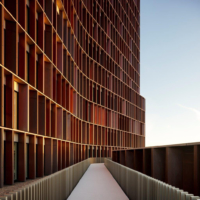Esitteet ja raportit
Pure copper is too soft for overhead wires and the copper alloys used are specified in BS EN 50149:2012. These are alloys of copper with respectively small amounts of silver, magnesium, tin or cadmium.
Copper alloys can be used for current cage designs as well as other future, more cost-effective designs and applications. Today, it can replace round HDPE cages, and square steel cages with and without platforms. Trials using the Aquapod 3600 and the OCAT cages with copper mesh are currently being conducted, and the Ocean Spar 3000 submersible cage is in prototype discussions.
Generally, the values of the International Annealed Copper Standard (IACS) are lower than those of wrought copper due to the presence of a small percentage of gas porosity and a small percentage of impurities such as iron. A value of 93% IACS is guaranteed but, with a very low porosity and very pure copper scrap (such as that from busbars), a value up to 102% IACS may be obtained.
Copper flame-free jointing can be done by press fittings and push-fit fittings. The benefits of these types of fittings are:
- Work can be undertaken with occupants in the building
- No flux fumes
- No additional ventilation required
- No need for hot work permits/certificates
- Quick to install.
Yes, any flux left inside the pipework must be removed after jointing is complete.
Energy efficiency: reducing the diameter of copper tubes in coils provides an economical path to energy efficiency for air conditioning and refrigeration (ACR) products.
Less material: tube-diameter reduction results in more effective heat transfer and consequently smaller, lighter coils. Less tube and fin material could provide equivalent heat transfer or more heat transfer; or the same material could provide much more heat transfer.
Less refrigerant: a dramatic reduction in refrigerant volume is a further benefit of copper tubes.
Durability: coils made of copper tubes and aluminium fins (CTAF) or copper tubes and copper fins (CTCF) are durable and dependable. They set the industry standard for corrosion resistance and long, reliable service life.
Familiarity: tube suppliers, OEMs, mechanical systems engineers and HVAC contractors are all highly familiar with CTAF technology. Up and down the value chain, the materials and processes are well understood.
When good heat transfer is essential, as in vehicle radiators, copper and brass are excellent choices due to their high thermal conductivity and ease of brazing, especially in thin sheets.
A high-purity copper wire harness system carries current from the battery throughout a vehicle to equipment such as lights, central locking, onboard computers and satellite navigation systems. Electric motors, which are wound with high conductivity wire, are also used in many vehicles. The average car contains about 1 km of wire.
Copper chromium (CC101) – conductivity is 80% IACS – strength good up to 400°C.
It reduces by about 3%.
An alloy with 89% copper, 5% aluminium, 5% zinc and 1% tin. 10, 20 and 50 Euro cent coins use this alloy.
Bright copper, pre-oxidised copper, pre-patinated copper or post-patinated copper. Copper surfaces can also be supplied embossed, hammered or perforated to offer a textured, or light-changing finish.
